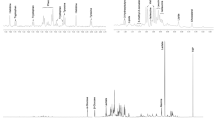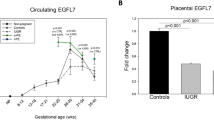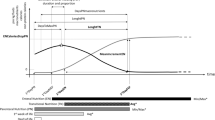Abstract
Primarily, our objectives were to compare system A amino acid transporter activity in the microvillous plasma membrane (MVM) of placentas from normally grown (appropriate for gestational age, AGA) and intrauterine growth-restricted (IUGR) fetuses delivered during the third trimester, as a whole and in relation to the severity of IUGR. Ten AGA and 16 IUGR pregnancies were studied at the time of elective cesarean section performed between 28 and 40 wk of gestation. Severity of IUGR pregnancies was assessed primarily by Doppler velocimetry and fetal heart rate monitoring. Placental MVM vesicles were prepared, and system A activity in these was measured. The transporter activity was significantly lower in IUGR compared with AGA pregnancies. Within the IUGR group system A activity was only significantly lower, compared with AGA, in cases that presented with a reduction in umbilical blood flow. We conclude that placental MVM system A activity is lower in IUGR compared with AGA pregnancies delivered during the third trimester. System A activity is related to the severity of IUGR.
Similar content being viewed by others
Log in or create a free account to read this content
Gain free access to this article, as well as selected content from this journal and more on nature.com
or
Abbreviations
- AGA:
-
appropriate for gestational age
- IUGR:
-
intrauterine growth restricted
- AIB:
-
aminoisobutyric acid
- MVM:
-
microvillous plasma membrane
- MeAIB:
-
methylaminoisobutyric acid
- PI:
-
pulsatility index
- FHR:
-
fetal heart rate
References
Daffos F, Capella-Pavlowsky M, Forestier F 1985 Fetal blood sampling during pregnancy with use of a needle guided by ultrasound: a study of 606 consecutive cases. Am J Obstet Gynecol 153: 655–660.
Marconi AM, Cetin I, Buscaglia M, Pardi G 1992 Midgestation cord sampling: what have we learned. Placenta 13: 115–122.
Cetin I, Corbetta C, Sereni LP, Marconi AM, Bozzetti P, Pardi G, Battaglia FC 1990 Umbilical amino acid concentrations in normal and growth-retarded fetuses sampled in utero by cordocentesis. Am J Obstet Gynecol 162: 253–261.
Economides DL, Nicolaides KH, Gahl WA, Bernardini I, Evans MI 1989 Plasma amino acids in appropriate and small-for-gestational-age fetuses. Am J Obstet Gynecol 161: 1219–1227.
Pardi G, Cetin I, Marconi AM, Lanfranchi A, Bozzetti P, Ferrazzi E, Buscaglia M, Battaglia FC 1993 Diagnostic value of blood sampling in fetuses with growth retardation. N Engl J Med 328: 692–696.
Morris FH, Boyd RDH, Mahendran D 1994 Placental transport. In: Knobil E and Neill JD (eds) The Physiology of Reproduction, 2nd Ed. Raven Press, New York, pp 813–860.
Moe A 1995 Placental amino acid transport. Am J Physiol 268:C1321–C1331.
Dicke JM, Henderson GI 1988 Placental amino acid uptake in normal and complicated pregnancies. Am J Med Sci 295: 223–227.
Mahendran D, Donnai P, Glazier JD, D'Souza SW, Boyd RDH, Sibley CP 1993 Amino acid (system A) transporter activity in microvillous membrane vesicles from the placentas of appropriate and small for gestational age babies. Pediatr Res 34: 661–665.
Sibley CP, D'Souza SW, Doughty I, Boyd RDH, Glazier JD, Kuruvilla A, Mahendran D 1995 Birthweight and sodium/proton exchanger activity in the term human placenta. Placenta 16: 469–470.
Powell TL, Illsley NP 1996 A novel technique for studying cellular function in human placenta: gestational changes in intracellular pH regulation. Placenta 17: 661–668.
Soothill PW, Ajayi RA, Nicolaides KN 1992 Fetal biochemistry in growth retardation. Early Hum Dev 29: 91–97.
Todros T, Ferrazzi E, Groli C, Nicolini U, Parodi L, Pavoni M, Zorzoli A, Zucca S 1987 Fitting growth curves to head and abdomen measurements of the fetus: a multicentric study. J Clin Ultrasound 15: 95–105.
Parazzini F, Cortinovis I, Bortolus R, Fedele L 1991 Standard di peso alla nascita in Italia. Ann Ost Gin Med Perin 112: 203–246.
Gosling RG, King DH 1974 Continuous wave ultrasound as an alternative and complement to x-rays in vascular examinations. In: Reneman RS (eds) Cardiovascular Applications of Ultrasound. North Holland, Amsterdam, pp 266–282.
Glazier JD, Jones CJP, Sibley CP 1988 Purification and Na+ uptake by human placental microvillous membrane vesicles prepared by three different methods. Biochim Biophys Acta 945: 127–134.
Kuruvilla AJ, D'Souza SW, Glazier JD, Mahendran D, Maresh M, Sibley CP 1994 Altered activity of the System A amino acid transporter in microvillous membrane vesicles from placentas of macrosomic babies born to diabetic women. J Clin Invest 94: 689–695.
Karl PI, Teichberg S, Fisher SE 1991 Na+-dependent amino acid uptake by human placental microvillous membrane vesicles: importance of storage conditions and preservation of cytoskeletal elements. Placenta 12: 239–250.
Kudo Y, Yamada K, Fujiwara A, Kawasaki T 1987 Characterisation of amino acid transport systems in human placental brush-border membrane vesicles. Biochim Biophys Acta 904: 309–318.
Cetin I, Ronzoni S, Marconi AM, Perugino G, Corbetta C, Battaglia FC, Pardi G 1996 Maternal concentrations and fetal-maternal concentration differences of plasma amino acids in normal (AGA) and intrauterine growth restricted pregnancies. Am J Obstet Gynecol 174: 1575–1583.
Cetin I, Marconi AM, Baggiani AM, Buscaglia M, Pardi G, Fennessey PV, Battaglia FC 1995 In vivo placental transport of glycine and leucine in human pregnancies. Pediatr Res 37: 571–575.
Dicke JM, Verges DK 1994 Neutral amino acid uptake by microvillous and basal plasma membrane vesicles from appropriate and small for gestational age human pregnancies. J Matern Fetal Med 3: 246–250.
Ross JC, Fennessey PV, Wilkening RB, Battaglia FC, Meschia G 1996 Placental transport and fetal utilization of leucine in a model of fetal growth retardation. Am J Physiol 270: E491–E503.
Acknowledgements
The authors thank Dr. S. W. D'Souza, Dr. A. Kuruvilla, and Prof. R. D. H. Boyd for their contributions to this study. We gratefully acknowledge the contribution of Dr. K. Thornburg (Oregon Health Sciences University) to the start of the collaborative project and to the development of the studies. We also thank Dr. Anna Maria Baggiani for her work in the laboratory.
Author information
Authors and Affiliations
Additional information
Supported by Italian National Research Council (CNR)-Targeted Project“Prevention and Control Disease Factors”; Subproject“FATMA” no. 95.00880.PF41.115.21807; by European Community Biomed 1, Contract no. BMH1-CT94-1715; by a Medical Research Council grant (C.P.S.); and an Action Research Endowment Fund (Department of Child Health, University of Manchester).
Rights and permissions
About this article
Cite this article
Glazier, J., Cetin, I., Perugino, G. et al. Association between the Activity of the System A Amino Acid Transporter in the Microvillous Plasma Membrane of the Human Placenta and Severity of Fetal Compromise in Intrauterine Growth Restriction. Pediatr Res 42, 514–519 (1997). https://doi.org/10.1203/00006450-199710000-00016
Received:
Accepted:
Issue date:
DOI: https://doi.org/10.1203/00006450-199710000-00016
This article is cited by
-
CHOP upregulation and dysregulation of the mature form of the SNAT2 amino acid transporter in the placentas from small for gestational age newborns
Cell Communication and Signaling (2023)
-
Fetal Sex Does Not Impact Placental Blood Flow or Placental Amino Acid Transfer in Late Gestation Pregnant Sheep With or Without Placental Insufficiency
Reproductive Sciences (2022)
-
Human placental uptake of glutamine and glutamate is reduced in fetal growth restriction
Scientific Reports (2020)
-
Reconciling the distinct roles of angiogenic/anti-angiogenic factors in the placenta and maternal circulation of normal and pathological pregnancies
Angiogenesis (2020)
-
Vasoactive Intestinal Peptide induces glucose and neutral amino acid uptake through mTOR signalling in human cytotrophoblast cells
Scientific Reports (2019)



